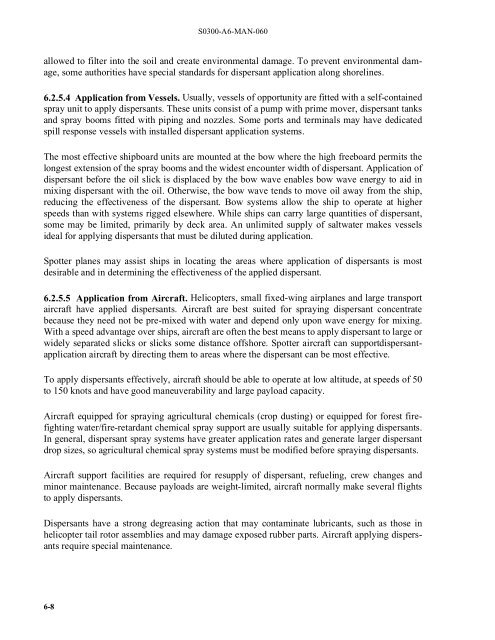U.S. Navy Ship Salvage Manual Volume 6 - Oil Spill Response
U.S. Navy Ship Salvage Manual Volume 6 - Oil Spill Response
U.S. Navy Ship Salvage Manual Volume 6 - Oil Spill Response
- No tags were found...
Create successful ePaper yourself
Turn your PDF publications into a flip-book with our unique Google optimized e-Paper software.
S0300-A6-MAN-060allowed to filter into the soil and create environmental damage. To prevent environmental damage,some authorities have special standards for dispersant application along shorelines.6.2.5.4 Application from Vessels. Usually, vessels of opportunity are fitted with a self-containedspray unit to apply dispersants. These units consist of a pump with prime mover, dispersant tanksand spray booms fitted with piping and nozzles. Some ports and terminals may have dedicatedspill response vessels with installed dispersant application systems.The most effective shipboard units are mounted at the bow where the high freeboard permits thelongest extension of the spray booms and the widest encounter width of dispersant. Application ofdispersant before the oil slick is displaced by the bow wave enables bow wave energy to aid inmixing dispersant with the oil. Otherwise, the bow wave tends to move oil away from the ship,reducing the effectiveness of the dispersant. Bow systems allow the ship to operate at higherspeeds than with systems rigged elsewhere. While ships can carry large quantities of dispersant,some may be limited, primarily by deck area. An unlimited supply of saltwater makes vesselsideal for applying dispersants that must be diluted during application.Spotter planes may assist ships in locating the areas where application of dispersants is mostdesirable and in determining the effectiveness of the applied dispersant.6.2.5.5 Application from Aircraft. Helicopters, small fixed-wing airplanes and large transportaircraft have applied dispersants. Aircraft are best suited for spraying dispersant concentratebecause they need not be pre-mixed with water and depend only upon wave energy for mixing.With a speed advantage over ships, aircraft are often the best means to apply dispersant to large orwidely separated slicks or slicks some distance offshore. Spotter aircraft can supportdispersantapplicationaircraft by directing them to areas where the dispersant can be most effective.To apply dispersants effectively, aircraft should be able to operate at low altitude, at speeds of 50to 150 knots and have good maneuverability and large payload capacity.Aircraft equipped for spraying agricultural chemicals (crop dusting) or equipped for forest firefightingwater/fire-retardant chemical spray support are usually suitable for applying dispersants.In general, dispersant spray systems have greater application rates and generate larger dispersantdrop sizes, so agricultural chemical spray systems must be modified before spraying dispersants.Aircraft support facilities are required for resupply of dispersant, refueling, crew changes andminor maintenance. Because payloads are weight-limited, aircraft normally make several flightsto apply dispersants.Dispersants have a strong degreasing action that may contaminate lubricants, such as those inhelicopter tail rotor assemblies and may damage exposed rubber parts. Aircraft applying dispersantsrequire special maintenance.6-8
















